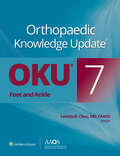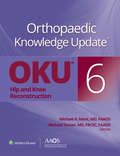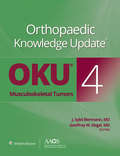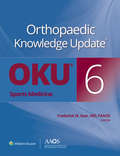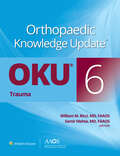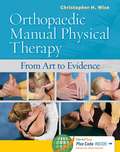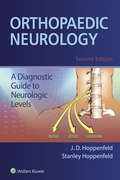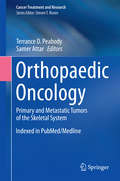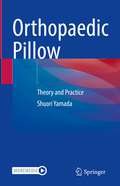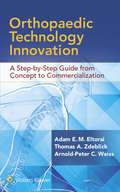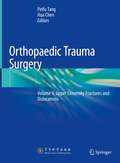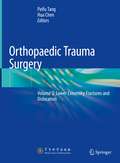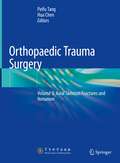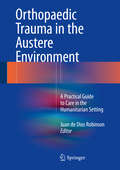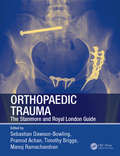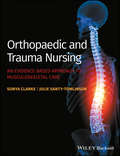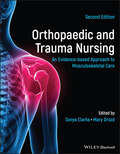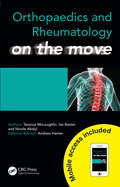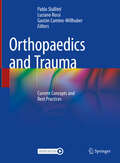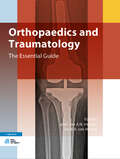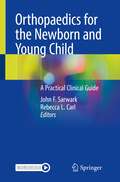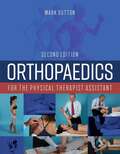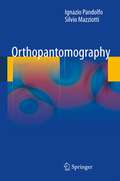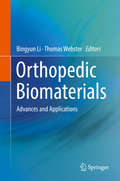- Table View
- List View
Orthopaedic Knowledge Update®: Foot and Ankle 7 (AAOS - American Academy of Orthopaedic Surgeons)
by Loretta B. ChouThis comprehensive orthopaedic resource covers all aspects of foot and ankle surgery in a single, convenient volume. Developed in partnership with the American Academy of Orthopaedic Surgeons (AAOS) and edited by Loretta B. Chou, MD, FAAOS, Orthopaedic Knowledge Update®: Foot and Ankle 7 presents relevant, evidence-based information, discusses its practical application, and provides supporting references, all tailored to the needs of today’s practicing orthopaedists and trainees. Written, edited, and peer-reviewed by dedicated foot and ankle surgeons, it offers a complete guide to the diagnosis, treatment, and management of orthopaedic foot and ankle injuries and disorders, supported by the latest evidence. The OKU® subspecialty series covers most important new developments since the last volume was published in 2019.
Orthopaedic Knowledge Update®: Hip and Knee Reconstruction 6 (Aaos - American Academy Of Orthopaedic Surgeons Ser.)
by Michael A Mont Michael TanzerExplore the many changes in hip and knee arthroplasty in recent years with completely new chapters on thromboprophylaxis, outpatient surgery, pain management, retrieval—hip and knee, medical and biologic treatment of arthritis, nonarthroplasty management, infection, periprosthetic fracture, anatomy and surgical approaches, and dual-mobility cups and large-diameter heads for primary and revision total hip arthroplasty. Expand your knowledge with the standard in adult hip and knee reconstruction, while you advance patient care with the best practices available. Developed in partnership with The Hip Society and The Knee Society, OKU® Hip and Knee Reconstruction 6 examines current research and reviews of the most relevant topics chosen by recognized authorities. Find a wealth of information on cutting-edge developments and approaches for surgically challenging conditions. Orthopaedic surgeons with a specialty interest in hip and knee reconstruction, and physicians and allied health interested in staying up to date on best practices will benefit from this edition. Residents in training can review key topics paired with helpful guidelines and images.
Orthopaedic Knowledge Update®: Musculoskeletal Tumors 3 (Orthopaedic Knowledge Update Ser.)
by J. Sybil Biermann Geoffrey SiegelLeading orthopaedic surgeons and specialists collaborated to provide this multidisciplinary perspective on musculoskeletal tumors. From the experience and insight of these health professionals, Orthopaedic Knowledge Update®: Musculoskeletal Tumors 4 offers a big-picture view of the latest innovations in tumor care and optimized treatment. This fourth edition reflects the recent cutting-edge research and understanding of the molecular basis of neoplastic disease and new treatment options.
Orthopaedic Knowledge Update®: Sports Medicine 6 (Aaos - American Academy Of Orthopaedic Surgeons Ser.)
by Frederick AzarOrthopaedic Knowledge Update®: Sports Medicine 6 brings together the most relevant literature and the latest research from the past 5 years. More than 150 top-notch contributors collaborated on this succinct review of pertinent advances in sports medicine. Find brand-new content on hip instability and microinstability, return-to-play criteria following anterior cruciate ligament injury, exercise-induced bronchorestriction, development of emergency action plans, and imaging of the foot and ankle.
Orthopaedic Knowledge Update®: Trauma (AAOS - American Academy of Orthopaedic Surgeons)
by Samir Mehta William M. RicciDeveloped in partnership with the American Academy of Orthopaedic Surgeons (AAOS) and edited by William M. Ricci, MD, FAAOS and Samir Mehta, MD, FAAOS, Orthopaedic Knowledge Update®: Trauma 6 brings together relevant knowledge and new breakthroughs in orthopaedic trauma treatment and management from the most recent 5 years of orthopaedic and subspecialty literature, as well as core knowledge from previous years.
Orthopaedic Manual Physical Therapy: From Art to Evidence
by Christopher H. WiseTake an eclectic, evidence-based approach to orthopaedic manual therapy. From theory through practical application of soft tissue and joint mobilization techniques--this comprehensive resource delivers the depth and breadth of coverage you need to optimize patient outcomes through informed clinical decision-making as part of a comprehensive intervention regimen.
Orthopaedic Neurology: A Diagnostic Guide To Neurologic Levels
by Stanley Hoppenfeld J. D. HoppenfeldSince its original publication, Orthopaedic Neurology: A Diagnostic Guide to Neurologic Levels has distinguished itself as a clearly written, uniquely focused text sought after by practitioners and trainees in orthopaedics, neurosurgery, physical medicine and rehabilitation, pain medicine, anesthesiology, neurology, and nursing, as well as primary care specialties. The second edition retains this standard of excellence while providing thorough updates in medical illustration, teaching techniques, and new approaches to the diagnosis and treatment of patients with spinal cord injuries. Now in vibrant full color, it offers a distinctive and practical combination of anatomy, the physical exam, and clinical pearls, highly readable and abundantly illustrated.
Orthopaedic Oncology
by Terrance D. Peabody Samer AttarThis text provides a comprehensive overview of orthopaedic oncology - the field of orthopaedic surgery that specializes in the evaluation and treatment of bone and soft tissue tumors of the musculoskeletal system. The opening chapters cover musculoskeletal imaging interpretation and the principles of musculoskeletal biopsy. Assessment and treatment of the full range of tumors are then described in a series of well-illustrated chapters. Detailed consideration is given to benign tumors, osteosarcomas, Ewing sarcomas, chondrosarcomas, metastatic bone disease of the axial and appendicular skeleton, and soft tissue sarcomas. This book will be invaluable for both orthopaedic surgeons and medical oncologists, providing a framework for understanding the fundamentals of these tumors and a sound basis for their treatment.
Orthopaedic Pillow: Theory and Practice
by Shuori YamadaBased on the clinical experiences and results of more than 50 years, this book discusses the theory and best practices of using pillows. It focuses on pillow requirements that address the issue with sleeping posture as well as the history and analysis of problems with the usage of pillows that are now on the market. The book also emphasizes sleep disorders, such as sleep apnea syndrome, as issues that can be resolved by pillows in addition to orthopedic spinal illnesses. Additionally, it describes the significance of utilizing mattresses, comforters, nightwears and other physical elements like lighting and temperature to create a conducive sleeping environment. The topic of keeping proper sleeping posture is also addressed. Since 1972, the author and her father have examined more than 120,000 patients and created a pillow adjustment technique. The authors have developed a method to identify the specific pillow height change that improves the patient's condition based on these data sets. The patient's condition has significantly improved as a result of the findings, and the book details the most recent development in the study. Professionals can incorporate the findings into their medical procedures to help individuals with their symptoms. Medical professionals who can use the technique and impart the knowledge to their patients, such as doctors, nurses, and engineers, are the intended audience. The English manuscript was created using machine translation (by the service DeepL.com), followed by the author revising, editing, and verifying the translated content.
Orthopaedic Technology Innovation: A Step-by-step Guide From Concept To Commercialization
by Adam Eltorai Thomas A. Zdeblick Arnold-Peter C. WeissHave an idea for a new tool or instrument? This a great resource to use to bring your invention ideas to the bedside! Written for clinicians, researchers, students, and entrepreneurs, this concise yet comprehensive review presents a clear process to identify, invent, and implement new technology solutions that aid in effective and safe practice in orthopedic surgery.
Orthopaedic Trauma Surgery: Volume 1: Upper Extremity Fractures and Dislocations
by Peifu Tang Hua ChenThe book adopts the principle of guiding surgery by anatomy, fixation by biomechanics, and clinical procedures by functional recovery. In each chapter, the applied anatomy of the fracture site is first introduced, which confers prominence to the relationship between the anatomical structure and surgery and emphasizes the structure that must be protected and repaired during surgery. In addition, the biomechanical characteristics of the fracture site are described, so that the appropriate fixation method can be selected according to the characteristics of the mechanical environment. In most chapters on periarticular fractures, the book also describes in detail how the joints fulfil their function, which is often the core of clinical decision-making, with the hope that the reader can understand the how and the why.The book adopts the outline-style format instead of the traditional paragraph-by-paragraph discussion to supply readers with the "extracted essence" in a more succinct manner, which improves the logical flow and concision and thereby improves the readability of the book. In addition, using more than 3,000 illustrations and photos in 3 volumes, many of which were obtained from our clinical practice, the book discusses injury mechanisms and the classification and assessment of extremity and axial skeleton fractures, with a focus on typical and new surgical methods developed in recent years. These illustrations and photos provide the reader with a good reference for learning surgical techniques and skills.This first volume is focusing on upper extremity fractures and dislocations in 9 chapters.
Orthopaedic Trauma Surgery: Volume 2: Lower Extremity Fractures and Dislocation
by Peifu Tang Hua ChenThis book adopts the principle of guiding surgery by anatomy, fixation by biomechanics, and clinical procedures by functional recovery. In each chapter, the applied anatomy of the fracture site is first introduced, which confers prominence to the relationship between the anatomical structure and surgery and emphasizes the structure that must be protected and repaired during surgery. In addition, the biomechanical characteristics of the fracture site are described, so that the appropriate fixation method can be selected according to the characteristics of the mechanical environment. In most chapters on periarticular fractures, the book also describes in detail how the joints fulfil their function, which is often the core of clinical decision-making, with the hope that the reader can understand the how and the why.This book adopts the outline-style format instead of the traditional paragraph-by-paragraph discussion to supply readers with the "extracted essence" in a more succinct manner, which improves the logical flow and concision and thereby improves the readability of the book. In addition, using more than 3,000 illustrations and photos in 3 volumes, many of which were obtained from our clinical practice, the book discusses injury mechanisms and the classification and assessment of extremity and axial skeleton fractures, with a focus on typical and new surgical methods developed in recent years. These illustrations and photos provide the reader with a good reference for learning surgical techniques and skills.This second volume is focusing on lower extremity fractures in 12 chapters.
Orthopaedic Trauma Surgery: Volume 3: Axial Skeleton Fractures and Nonunion
by Peifu Tang Hua ChenThe book adopts the principle of guiding surgery by anatomy, fixation by biomechanics, and clinical procedures by functional recovery. In each chapter, the applied anatomy of the fracture site is first introduced, which confers prominence to the relationship between the anatomical structure and surgery and emphasizes the structure that must be protected and repaired during surgery. In addition, the biomechanical characteristics of the fracture site are described, so that the appropriate fixation method can be selected according to the characteristics of the mechanical environment. In most chapters on periarticular fractures, the book also describes in detail how the joints fulfil their function, which is often the core of clinical decision-making, with the hope that the reader can understand the how and the why.The book adopts the outline-style format instead of the traditional paragraph-by-paragraph discussion to supply readers with the "extracted essence" in a more succinct manner, which improves the logical flow and concision and thereby improves the readability of the book. In addition, using more than 3,000 illustrations and photos in 3 volumes, many of which were obtained from our clinical practice, the book discusses injury mechanisms and the classification and assessment of extremity and axial skeleton fractures, with a focus on typical and new surgical methods developed in recent years. These illustrations and photos provide the reader with a good reference for learning surgical techniques and skills.This third volume is focusing on axial skeleton fractures and nonunion in 5 chapters.
Orthopaedic Trauma in the Austere Environment
by Juan de Dios RobinsonOrthopaedic trauma represents 75% of the casualties in a disaster. Many of these patients will be cared for by international volunteers, but good intentions are not always matched by good preparation. This book explains how best to prepare for missions, how to deal with injuries in austere conditions, how to ensure a positive legacy, and the need for cultural, political, and legal awareness. All of the most common orthopaedic presentations encountered in the austere environment are covered. In addition to evidence-based research, cases and actual experiences from the authors' missions are included to illustrate and bring to life key points. This book, written by a team of international experts with extensive experience of challenging field missions, will be an ideal practical guide for volunteers and health care workers, helping them to deal with confusing, chaotic, and distressing situations with greater confidence and efficacy.
Orthopaedic Trauma: The Stanmore and Royal London Guide (In Clinical Practice Ser.)
by Manoj Ramachandran Sebastian Dawson-Bowling Pramod Achan Timothy BriggsHighly Commended, BMA Medical Book Awards 2015 <P><P>Orthopaedic Trauma: The Stanmore and Royal London Guide is a definitive and practical guide to musculoskeletal trauma surgery with an emphasis on the techniques employed and the reasoning behind them. Written with the needs of trainees in orthopaedic surgery in mind, this comprehensive book systematical
Orthopaedic and Trauma Nursing
by Sonya Clarke Julie Santy-TomlinsonOrthopaedic and Trauma Nursing provides practitioners working in orthopaedic and musculoskeletal trauma settings with the essential evidence, guidance and knowledge required to underpin effective practice. This comprehensive and contemporary textbook explores the variety of adult and paediatric clinical settings where orthopaedic and trauma practitioners work, including acute wards, clinics, community hospitals, nursing homes and patients' homes. Divided into 5 sections, this book looks at: key issues in orthopaedic and musculoskeletal trauma care; specialist practice issues; common orthopaedic conditions and their care and management; musculoskeletal trauma care; and care of children and young people. Suitable for students at degree level as well as those clinicians practicing in more advanced orthopaedic and trauma care roles, Orthopaedic and Trauma Nursing is a foremost authority on orthopaedic and musculoskeletal practice for both students and practitioners. Orthopaedic and Trauma Nursing: Is strongly supported by the latest evidence, with chapters summarizing evidence, with reference to relevant and seminal research Offers practical guidance based on the relevant evidence Focuses on the perspective of the patient with patient narrative and case studies throughout Includes a section specifically dealing with children and young people
Orthopaedic and Trauma Nursing: An Evidence-based Approach to Musculoskeletal Care
by Sonya Clarke Mary DrozdOrthopaedic and Trauma Nursing A comprehensive and evidence-based manual for orthopaedic and trauma nurses and students In the newly revised second edition of Orthopaedic and Trauma Nursing: An Evidence-based Approach to Musculoskeletal Care, a team of accomplished practitioners and educators deliver a straightforward and practical textbook for the practice of neonate, infant, child, young person, adult and older person orthopaedic and trauma nursing. The book explores topics of critical importance to those working in acute wards, clinics, community hospitals, nursing homes, and patients’ homes. Divided into 5 intuitive sections, this book examines central issues in orthopaedic and musculoskeletal trauma care, specialist practice issues, the care and management of common conditions, and the care of infants, children and young people. Each chapter is based on the latest research and offers practical guidance to practitioners around the world. The book also offers: Practical explorations of topics in specialist practice, including assessment, common musculoskeletal interventions, and complications of musculoskeletal conditions and trauma In-depth discussions of common orthopaedic conditions and their management and care, including elective orthopaedic surgery Holistic musculoskeletal trauma care, including the principles of trauma and fracture management Perfect for pre-registration and qualified adult and children’s orthopaedic nurses working in orthopaedic and musculoskeletal trauma units in hospitals and community settings, Orthopaedic and Trauma Nursing will also be of use to students seeking post-qualification education in orthopaedic nursing.
Orthopaedics and Rheumatology on the Move (Medicine on the Move)
by Ian Baxter Terence McLoughlin Nicole AbdulThe Medicine on the Move series provides fully flexible access to subjects across the curriculum in a unique combination of print and mobile formats ideal for the busy medical student and junior doctor. No matter what your learning style, whether you are studying a subject for the first time or revisiting it during exam preparation, Medicine on the
Orthopaedics and Trauma: Current Concepts and Best Practices
by Pablo Slullitel Luciano Rossi Gastón Camino-WillhuberThis book provides an easy-going, high-quality and updated work focused on the most common diagnoses of Traumatology and Orthopaedics. It's structured with several sub-headings, including bullet-point tips for basic concepts.Each chapter is focused on a specific pathology and includes the following sub-headings: short introduction, applied anatomy and physiology, prevalence, classification, diagnosis (including anamnesis, physical examination and complementary imaging, from plain x-ray to cross-sectional imaging), treatment (conservative-surgical options), controversies, complications, future directions and author’s preference for treatment apart from references. Orthopaedics and Trauma - Current Concepts will be an inspiration to the young orthopaedic resident, fellow or even general orthopaedic surgeon and senior medical student. It will definitely help with their careers and also be a useful tool to prepare for the board certified orthopaedic examination.
Orthopaedics and Traumatology: The Essential Guide
by J.A.N. Verhaar J.B.A. van MourikOrthopaedics and Traumatology: The Essential Guide is a completely new textbook in the English language, but has a long history in the Netherlands. For physicians and medical students, physiotherapists and students, general practitioners and orthopaedic nurses: this textbook has been the main source of orthopaedic knowledge for decades.Orthopaedics and Traumatology: The Essential Guide deals with the diagnosis and treatment of the most common disorders of the musculoskeletal system, both surgical and non-surgical. It is made up of four sections: basic knowledge, traumatology, orthopaedics in children and adult orthopaedics. To make studying easier, the text is interspersed with interludes, key points and more than 500 illustrations. All authors are experts in their fields.Lower back pain and other musculoskeletal disorders are among the disorders with the greatest burden of disease. This burden will increase with the continued ageing of our global population. However, orthopaedic disorders and injuries can occur not only in the elderly, but at any age. They may cause disability, reduce quality of life and sometimes lead to loss of independence. As a result, the costs to society are high. Fortunately, there is an increasing number of successful treatment options.When treating orthopaedic and trauma patients, close cooperation and efficient communication is essential between doctors of different medical specialities, between primary and secondary care, and between doctors and paramedics. We expect this book to be invaluable in medical and paramedical training.The complete book is available online with access to embedded videos and deep links. You can also test your new competencies and knowledge using case studies and tests at the end of each chapter.
Orthopaedics for the Newborn and Young Child: A Practical Clinical Guide
by John F. Sarwark Rebecca L. CarlPrimary care providers caring for newborns must be able to recognize orthopaedic disorders that affect infants, particularly when these conditions require early treatment or are part of an underlying syndrome. This book provides pediatricians, neonatologists, family medicine physicians and licensed independent practitioners with a useful framework for the diagnosis and management of common pediatric orthopaedic conditions that typically present during infancy. The text begins with an overview of orthopaedic embryology and relevant physical examination techniques. The second section details congenital and developmental conditions affecting the limbs and spine. The third section includes topics related to birth trauma. The final section focuses on orthopaedic manifestations of systemic diseases and syndromes. Each chapter has a consistent, intuitive layout including a brief overview and sections on clinical presentation, evaluation and management, as well as a detailed discussion of the condition being discussed. When relevant, clinical vignettes are included to illustrate practical application of the subject matter. The design of the sections allow providers to easily reference appropriate information in the clinic setting. Written by experts in the field, Orthopaedics for the Newborn and Young Child is a valuable resource for pediatric orthopaedic providers, primary care physicians and other specialists who treat children.
Orthopaedics for the Physical Therapist Assistant
by Mark DuttonBoasting a new full-color design, Orthopaedics for the Physical Therapist Assistant, Second Edition provides students with evidence-based guidelines for the assessment and rehabilitation of the orthopaedic patient. <p><p>After considering the fundamental knowledge and skills needed by the PTA student, the text then explores therapeutic activities and the orthopaedic management of specific joints. These joint chapters follow a uniform structure that considers relevant anatomy and kinesiology, examination techniques, common pathologies, and the various strategies and techniques with which they can be addressed. <p><p>Orthopaedics for the Physical Therapist Assistant utilizes a range of pedagogical features to improve learning and retention. These include Chapter Objectives that assist students in identifying key learning outcomes; Key Point boxes that emphasize important concepts, and Case Studies that allow students to apply their knowledge. Each chapter ends with Review Questions that test retention of key concepts.
Orthopantomography
by Silvio Mazziotti Ignazio PandolfoAlthough orthopantomography (OPT) is a very frequently employed radiological examination, even the expert radiologist can encounter difficulty in reporting the findings owing to the specific terminology, the nature of the diagnostic queries, and the need to describe precisely the clinical implications for the dentist. Additionally, artifacts are a frequent occurrence, and many radiologists and dentists are unfamiliar with their causes and solutions. Methodological inaccuracies during the execution of OPTs also have important clinical implications. For all of these reasons, this richly illustrated monograph on OPT sets out to describe in detail diverse technical and methodological aspects of the examination, from image acquisition through to artifact generation due to lack of experience or malfunctioning. Possible solutions are suggested for all of the most common diagnostic and methodological problems. Emphasis is placed on appropriate terminology and guidance offered on the interpretation of findings in a range of conditions, including the most common odontological problems. This book will be of great value to the radiologist in routine interpretation and reporting of OPTs.
Orthopedic Assessment in Massage Therapy
by Whitney LoweManual soft-tissue therapies are a tremendous benefit in treating musculoskeletal problems. As massage continues to grow as a valuable treatment option client's expectations are increasing. The client who reads about the positive aspects of massage treatment in popular magazines will want that experience in the clinic.
Orthopedic Biomaterials: Advances And Applications
by Bingyun Li Thomas WebsterThis book covers the latest advances, applications, and challenges in orthopedic biomaterials. Topics covered include materials for orthopedic applications, including nanomaterials, biomimetic materials, calcium phosphates, polymers, biodegradable metals, bone grafts/implants, and biomaterial-mediated drug delivery. Absorbable orthopedic biomaterials and challenges related to orthopedic biomaterials are covered in detail. This is an ideal book for graduate and undergraduate students, researchers, and professionals working with orthopedic biomaterials and tissue engineering. This book also:Describes biodegradable metals for orthopedic applications, such as Zn-based medical implantsThoroughly covers various materials for orthopedic applications, including absorbable orthopedic biomaterials with a focus on polymers Details the state-of-the-art research on orthopedic nanomaterials and nanotechnology
